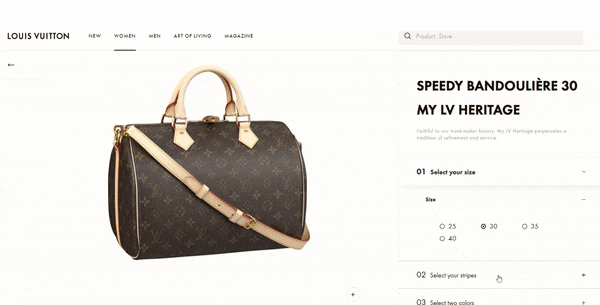
People want to be more than just consumers today. They want to be co-designers of products that represent their unique personalities. And this is especially true when it comes to luxury products. In McKinsey & Company’s marketing’s Holy Grail, luxury brand personalization is an opportunity to engage with customers while enriching their lives and fostering loyalty.
According to this report, an effective luxury brand personalization strategy can help reduce acquisition costs by 50% and increase revenues by as much as 15%. You can also etch out another 10-30% in the marketing-spend efficiency.
Many luxury brands have dabbled in product and journey personalization. However, the real value is usually only realized incrementally if you’re using a trial and error approach. This process is time-consuming, tedious, and more often than not, off-target.
Read on and discover everything you need to know to get your luxury product personalization strategy right the first time.
Luxury brand personalization takes a journey lens to each touchpoint between you and the customer. It includes the marketing messages, the content you deliver, and allowing shoppers to customize products on the fly. When it comes to luxury items, the entire experience will affect a shopper’s perception of quality, values, and individuality.
Three of the ways personalization can draw in luxury consumers are:
To succeed with luxury personalization, you must disregard the monolithic approach to marketing and embrace the omnichannel experience. Physical stores are experience centers. Ecommerce sales are data sets. And each touchpoint you provide is an opportunity to engage on a personal level with customers.
Most brands that succeed at luxury personalization connect the buying journey to an individualized experience. Louis Vuitton’s Gifts for Women collection quickly lets a buyer know that the product they choose is part of a wider experience and the choice of item enhances the sum of the whole journey. It’s a simple way to create a collection of products that evoke an idea of love. It also demonstrates the special value placed on the intended recipient.
A simple approach like this is a great first step when developing your brand personalization strategy. However, it may not be enough if you want to foster loyalty and stand out above your competitors. Let’s look at what luxury brand personalization should look like under the hood.
In an article from 2015, HBR lists the 3 D’s of personalization that brands should use to develop an integrated strategy at scale. These are:
At the heart of personalization is the collection, dissemination, and contextualization of customer-centric data. Many organizations track elements like abandonment, purchase history, and conversion rates. However, these metrics do not necessarily allow you to track actual engagement across your omnichannel experiences.
How customers interact with your websites, use your apps, move the mouse on the product page, and respond to social media posts aren’t easy to quantify or qualify.
To build a luxury customization and personalization strategy that works, you’ll need to find a way to analyze large sets of structured and unstructured data.
Analytical models that quantify your data sets allow you to make data-driven decisions about products, experiences, campaigns, and pricing. Each interaction with a prospective customer is another opportunity to communicate your brand values and demonstrate your ability to personalize their experience.
There are many types of analytical models you can choose from, but the main requirement is to use internal decisions to guide customers to your desired outcome. The key remains that you should use some form of unbiased, non-linear approach to uncover the intent behind each interaction. And you should then leverage that information to build truly personalized experiences.
Consider Fender as an example. You know most guitar fanatics will spend years looking for the perfect electric guitar or bass. The ability to hop online, design your ideal Stratocaster® and have it delivered directly to your door is revolutionary in the guitar industry. Gathering this data for further analysis can help the company to streamline product development, adjust styles, and even bring back a classic guitar design if that’s what the data shows.
Via Fender
Finally, the way you package and distribute personalized content is vital to ensure your personalized messaging has the desired effect. It could include gamified experiences, participating in social awareness campaigns, including augmented reality (AR) experiences, and including 3D product visualization in your omnichannel servicing technologies.
A product customization platform allows you to provide rich and engaging experiences across your digital channels that exemplify personalization for your luxury brand.
You can include a special logo on a product to demonstrate support for a specific cause, provide complete product customization capabilities, and let your customers share their unique designs over social channels. With a product personalization platform, you’re able to respond to market changes and adapt to evolving consumer behavior effectively. And this will lead to higher levels of customer satisfaction while fostering brand loyalty for your luxury goods company.
Take a look at Louis Vuitton’s luxury product personalization experience for some inspiration. The brand empowers customers to add a personal touch to their handbags, wallets, shoes, and many other luxury products through an interactive online experience.

Via Louis Vuitton
In today’s competitive luxury goods market, consumers make buying decisions based on personality. Any brand that wants to grow revenues, reduce acquisition costs, and increase marketing efficiency should consider using a product personalization platform.
ConfigureID’s premium product personalization platform enables seamless product personalization and customization experiences. We're a trusted partner to top luxury brands like Louis Vuitton, Fender, Michael Kors, and Ralph Lauren.
Looking to take your luxury brand personalization capabilities to new heights? Schedule your live demo of ConfigureID today.